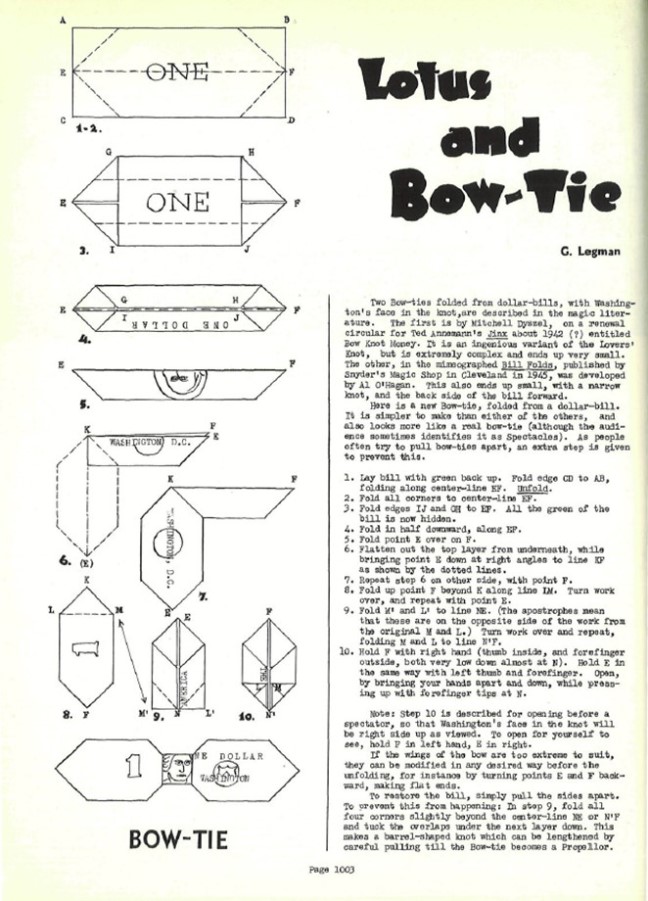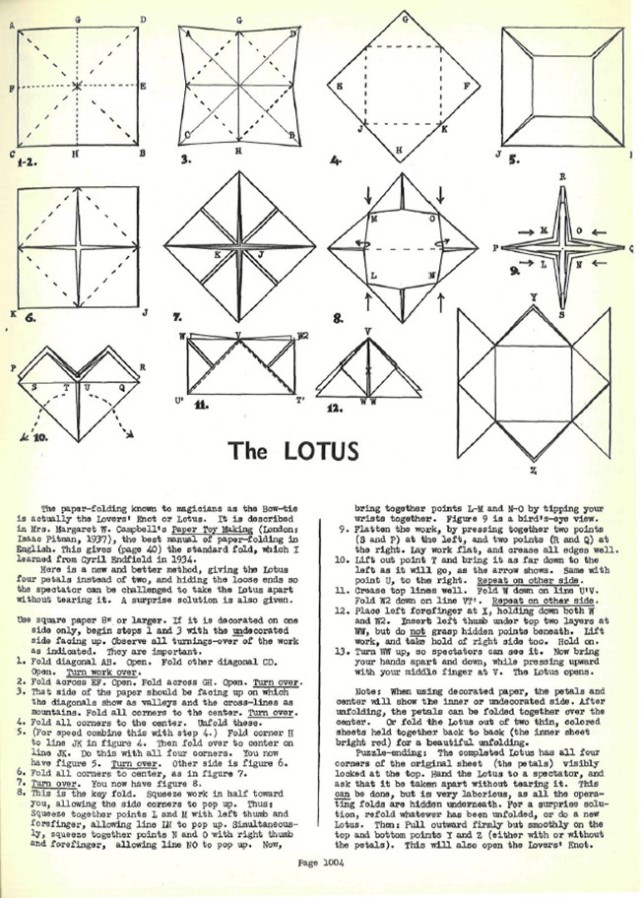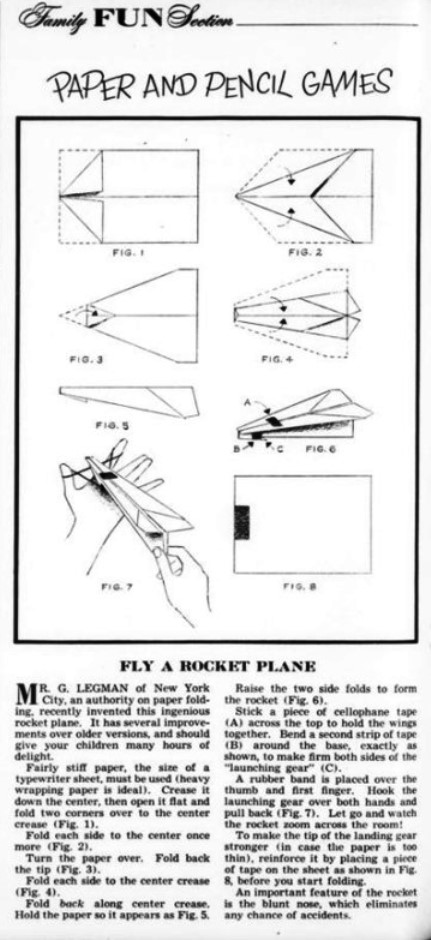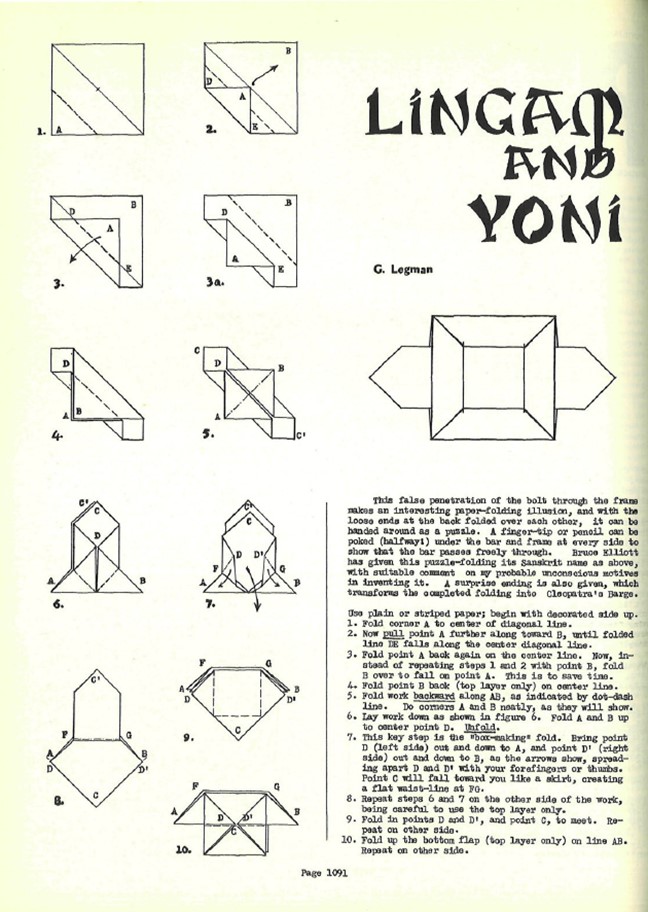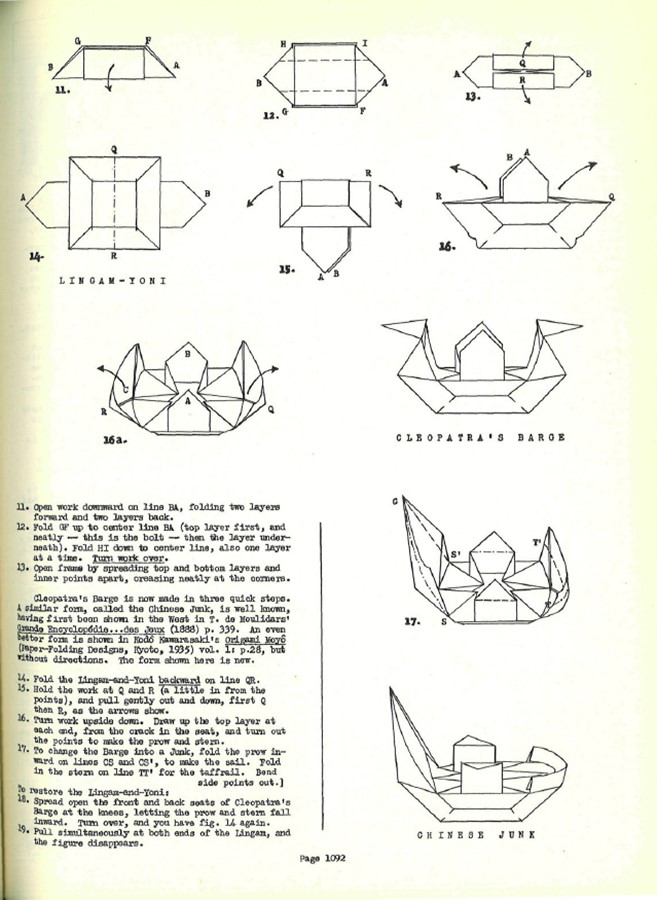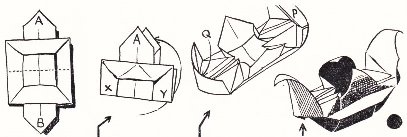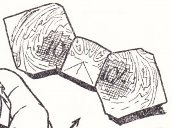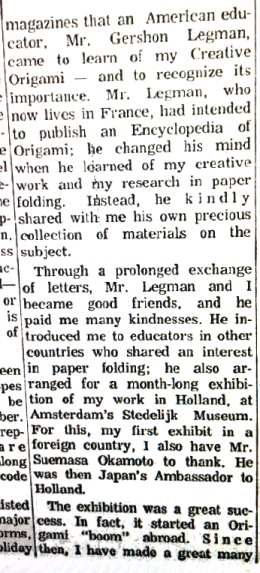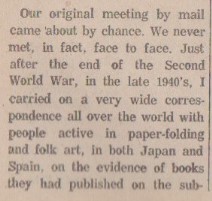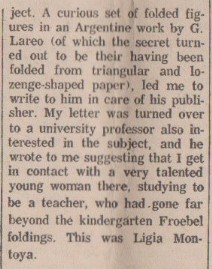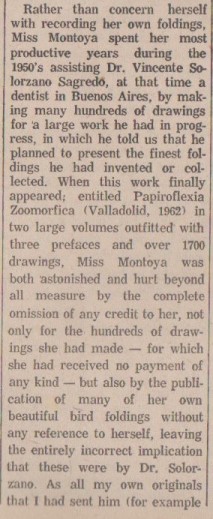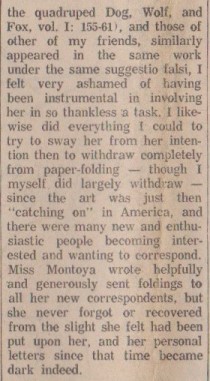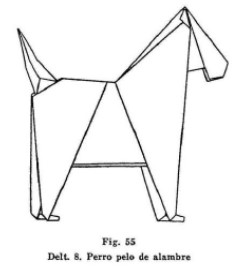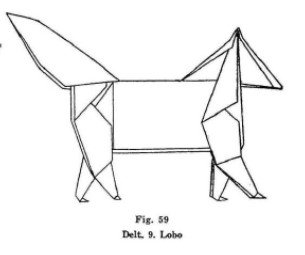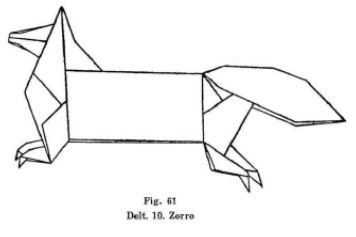| The Public Paperfolding History Project
x |
|||||||
| The Paperfolding of Gershon Legman | |||||||
Introduction Gershon Legman was born on November 2nd, 1917 in Scranton, Pennsylvania, and died in France on February 23rd, 1999. ********** Chronology 1934 In his article in 'The Phoenix' issue 251 of March 21st 1952, Legman says about the Lotus, 'This gives ... the standard fold which I learned from Cy Endfield in 1943.' See below. The 'standard fold' is, of course, the Lover's Knot. ********** 1952 Legman's bill folds 'Lotus and Bow-Tie' appeared in 'The Phoenix' issue 251 of March 21st 1952. Information from Edwin Corrie. The Lotus is a version of the Lover's Knot (but folded from a blintzed square) which can be opened up by pulling on the top and bottom points. The Bow-Tie is folded from a dollar bill.
********** According to David Lister (see his article on Martin Gardner) Gershon Legman published a preliminary edition of his bibliography in the magazine "Magicol" in May 1952. The full version was privately published in booklet form as 'Bibliography of Paper Folding' later in the same year. ********** A design for a rubber band launched plane, attributed to Gershon Legman, was published in an article by Martin Gardner in 'Parents' magazine for September 1952.
********** 1953 Legman's 'Lingam and Yoni' and 'Cleopatra's Barge'' designs appeared in 'The Phoenix' issue 273 of January 1953. Information from Edwin Corrie. One is developed from the other.
********** 1955 Legman arranged an exhibition of Akira Yoshizawa's paperfolds at the Stedelijk Museum in Amsterdam in October and November 1955. He attended the exhibition and taught paperfolding classes there. ********** Some photographs of a few of the exhibits can be found in an article in the Dutch magazine Goed Nieuws of 17th December, 1955. The article includes a historical theory that 'Three centuries ago in Japan, Dutch seamen, who had sailed to the East to fetch silks, fabrics and embroidery, and jewellery made of jade, and wonderfully thin porcelain, sat around folding birds out of paper with clumsy fingers. They would probably stay away for years and, of course, when they said goodbye in Amsterdam, on the quay at Schreierstoren or Enkhuizen or Vlissingen, they would have promised their children that they would bring back strange Eastern gifts. And they did, and the best of these was probably one of those little paper birds that could really flap its wings. The seamen would have learned to fold this themselves in Japan, where the art of paperfolding was already centuries old. The children could also learn such a bird or a horse or a rooster themselves, to fold when father was away again in the East.' This information almost certainly came from Gershon Legman, and, since there is no evidence of its authenticity, was possibly invented by him. Inter alia this article states that Legman 'wrote over a hundred letters to Yoshizawa but got no reply until he wrote his one hundred and seventeenth letter.' This statement was completely untrue. In fact Legman only wrote once to Yoshizawa, and that letter was returned undelivered. His contact with Yoshizawa began after he wrote a letter to Saburo Ueda to which Yoshizawa replied. (See article Unwrapping the Riddle of Yoshizawa-Legman by Laura Rozenberg, published in The Fold issue 68 of January / February 2022.) This article also contains a version of the story about Legman attempting to rescue a cat from a tree (though in this case a lamppost) but ending up breaking his ankle, and that the enforced rest this brought about led to a revival of his boyhood interest in paperfolding. 'Gershon Legman ... once wanted to rescue a cat from a lampost. The cat jumped down but Mr Legman fell and broke his ankle. In the weeks when he had to lie in bed and was bored he started reading and folding paper, and he has been at it ever since.' ********** 1956 On 15th January 1956, the Italian newspaper 'La Patria Unita' published an interview with Legman, which took place in Paris. The title reads: 'Folding Paper is an Art: The Hungarian doctor and psychoanalyst Gershon Legman brings for the first time to Europe the oriental secret entrusted to him by the Japanese master and philosopher Akira Yoshizawa'. Gershon Legman was not in fact Hungarian, though his parents were both of Hungarian-Jewish descent, and he was neither a doctor nor a psychoanalyst. Equally Akira Yoshizawa was not a philosopher. Legman states that he was in Paris to arrange a paperfolding exhibition at the Musee de L'Homme at the Palais de Chaillot. As far as I know this exhibition never took place. I have not fully transcribed or translated this article and it may contain other information of interest. ********** 'The Best in Magic' by Bruce Elliott, which was published by Harper & Row, Publishers, Inc in New York in 1956, and subsequently republished as 'Magic: 100 New Tricks' by Faber and Faber in London in 1957, contained diagrams for the same four paperfolds by Gershon Legman which had previously appeared in 'The Phoenix', (see entries above) although the 'Lingam and Yoni' was renamed 'Bolt and Frame'. The illustrations are identical in both versions, although some of the words have been changed in the British edition eg 'dollar bill' becomes' 'Treasury note'. ********** The introduction to Robert Harbin's book 'Paper Magic', published in 1956, contains several references to Legman and quotes widely from the first letter he wrote to Harbin on 8th April 1955. (The original letter is held in the archives of the Museo del Origami in Uruguay.)
*** 'Paper Magic' also contains diagrams for Legman's 'Lingam and Yoni', but here called the 'Bar and Bolt', 'Cleopatra's Barge'.
and the Bow Tie, where the text says, 'This excellent variation of the Lover's Knot was shown by Mr Cy Endfield to Mr Gershon Legman.' It seems to me that this is a misunderstanding of the fact that it was Endfield who first showed Legman the Lover's Knot way back in 1934.
********** 1958 On 27th June 1958 Meyer Berger's 'About New York' column in the New York Times featured Lillian Oppenheimer and her love of paperfolding. The column was titled 'Origami, the Ancient Art of Paper-Folding, has Gramercy Square Disciple' and contains a brief mention of Legman:
*** Volume 1, Issue 1 of 'The Origamian', which was published in October 1958, contains excerpts from letters from Gershon Legman to Lillian Oppenheimer critical of the name 'Origamian', promising to send Yoshizawa's folds for display at the Cooper Union and:
********** 1959 Volume 1, Issue 2 of 'The Origamian', which was published in November 1959, gives a list of the people Lillian Oppenheimer has made 'Honorary Members' of the Origami Center, including Gershon Legman. *** Volume 1, Issue 3 of 'The Origamian', which was published in December 1959 contains another quote from a Legman letter calling the Origamian a 'smearily printed magazine'. ********** 1962 Vol 3: Issue 1 of 'The Origamian' for Winter 1962/3 contains a profile of Neal Elias written by Peter Van Note, which credits Gershon Legman with fanning his interest in origami into flame.
********** 1963 Vol 3: Issue 3 of the Origamian for Autumn 1963 contains an article by Akira Yoshizawa on 'Creative Origami', which was originally published in Kokusai Bunka magazine in January 1961, which includes reference to Gershon Legman:
********** 1968 Vol 8: Issues 1 and 2 of 'The Origamian' for Spring and Summer 1968 contained a profile of Ligia Montoya, 'Ligia Montoya: Woman and Artist', written by Gershon Legman, with whom she had corresponded for many years, which gives some information about their relationship:
The designs in 'Pappiroflexia Zopomorphica' of which Legman claimed authorship were: Perro Pelo de Alambre (Wire Haired Terier)
********** Lobo (Wolf)
********** Zorro (Fox)
********** |
|||||||
